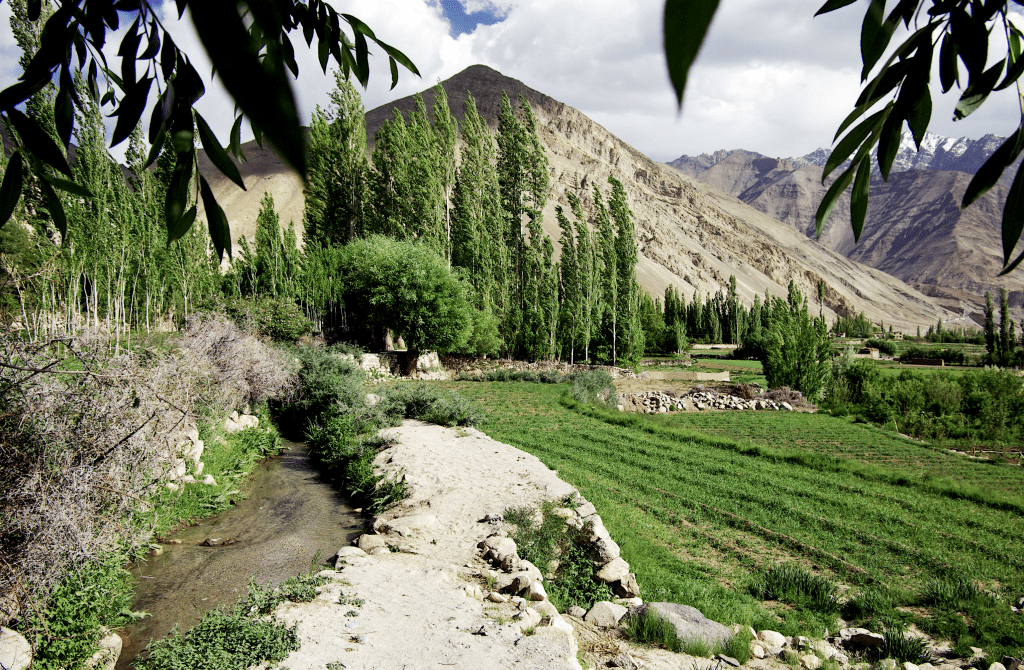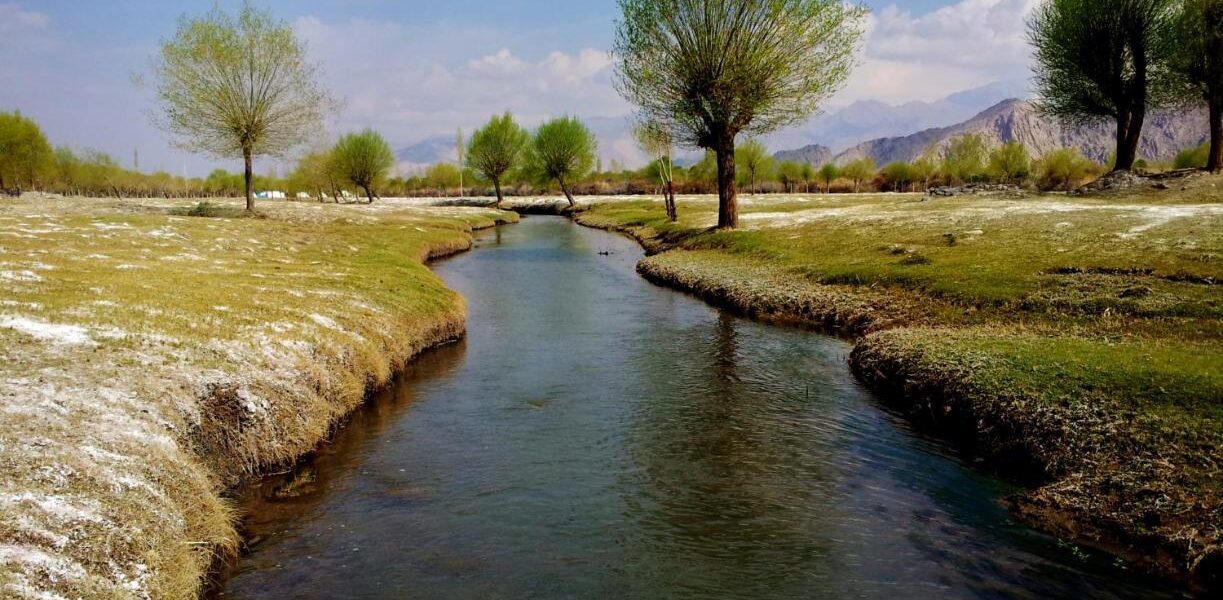Ladakh, a high-altitude desert nestled within the Himalayas, is known for its breathtaking landscapes, vibrant culture, and ancient systems of sustainable agriculture. A key part of this legacy is Ladakh’s traditional irrigation channels, known locally as khuls. These waterways serve as the lifeblood of Ladakhi villages, channeling glacial meltwater from mountains to farmlands, sustaining both crops and communities. In this journey along Ladakh’s ancient irrigation channels, we’ll explore their history, cultural importance, environmental impact, and resilience amid modern-day challenges.
Introduction to Ladakh’s Living Waterways
The Unique Irrigation Heritage of Ladakh
Ladakh’s high-altitude desert environment presents unique challenges for agriculture. Unlike other regions, the absence of regular rainfall means that farming here relies entirely on glacial meltwater, carried through a series of carefully maintained channels. These khuls reflect centuries of indigenous knowledge, community collaboration, and remarkable engineering.
“Our ancestors created these channels to bring water where there was none. Without them, life here would be impossible.” — Sonam Dorje, Farmer, India
Importance of Water in Ladakh’s Culture and Environment
In Ladakhi culture, water is more than a resource—it is sacred. Water rituals often take place in Buddhist monasteries, highlighting the spiritual importance of water in a region where it is naturally scarce. Community ceremonies, seasonal festivals, and agricultural practices are woven around the flow of water from these channels.

Understanding Ladakh’s Ancient Irrigation Channels
Origins and History of Ladakh’s Irrigation Systems
The origins of Ladakh’s irrigation systems date back centuries, shaped by necessity and respect for nature. Indigenous Ladakhi communities devised these water management systems to survive in an environment with limited resources. The khul systems were developed to harness seasonal snowmelt from glaciers, making them essential to both survival and farming.
“Learning about the history of these channels is like stepping back in time. It’s amazing to see how these systems have lasted through generations.” — Emma White, History Professor, UK
Structure and Function of the Khul Irrigation System
Khuls are constructed as narrow, winding channels that direct glacial meltwater across villages and agricultural plots. Typically, these channels are hand-dug along the natural slopes of the mountains to maximize gravity-fed water flow. The water is carefully monitored and distributed to ensure that each field receives enough.
“These systems are incredibly well-designed, using natural slopes and gravity to carry water without modern technology.” — Tenzin Norbu, Engineer, India
Community-Based Water Management in Ladakh
Water management in Ladakh is deeply community-oriented, with a cooperative approach to distribution and maintenance. Villagers gather to clear blockages, repair sections damaged by landslides, and ensure the channels are ready for the next planting season. Water rights are traditionally passed down through families, with leaders designated to manage distribution.
The Environmental Importance of Ladakh’s Irrigation Channels
Role of Glacial Meltwater in Ladakh’s Agriculture
Glaciers are the source of life in Ladakh’s desert environment. As these glaciers melt each spring, they release water that flows into the khuls and sustains farmlands. This seasonal flow determines planting schedules, and farmers must carefully align crop cycles with the availability of water.
“Living in an environment where water is so precious has taught me to respect and value every drop.” — Lobsang Tashi, Agriculture Advocate, Norway
Adapting Ancient Irrigation to Climate Change
Climate change poses a significant threat to Ladakh’s water resources. Rising temperatures are accelerating glacial melt, impacting the flow of water through these ancient channels. In response, local communities are actively seeking solutions, from building reservoirs to experimenting with new farming methods that require less water.
“Adapting our ancient methods to survive the future has become a priority for us.” — Namgyal Lhamo, Environmental Researcher, USA
Water Scarcity Challenges in High-Altitude Deserts
Ladakh is one of the driest inhabited regions on earth, and water scarcity is a constant concern. Traditional irrigation channels provide a sustainable water management solution that conserves resources while allowing limited agriculture in an otherwise barren landscape.
| Region |
Annual Rainfall (mm) |
Main Water Source |
Primary Challenge |
| Leh Valley |
~100 |
Glacial Meltwater |
Seasonal water shortage |
| Nubra Valley |
~80 |
Glacial Meltwater |
Increased water demand |
| Zanskar Valley |
~70 |
Snow-fed Streams |
Erratic water supply |

The Cultural and Social Significance of Water in Ladakh
Cultural Rituals and Water Management in Ladakhi Villages
In Ladakhi villages, water management is closely tied to community traditions. Seasonal rituals mark the beginning of the irrigation season, often involving blessings by Buddhist monks. These rituals honor the significance of water and seek divine guidance for a successful harvest.
Community Stewardship and Water Rights
Water rights in Ladakh are respected and guarded. Typically, landowners have rights to water based on the amount of land they own, but community leaders ensure fair distribution among all. This social structure has helped maintain peace and cooperation within villages.
“Our community is like a family when it comes to water. We help each other, because we all depend on this precious resource.” — Wangchuk Dorje, Village Elder, India
Sustainable Agriculture Supported by Ladakh’s Irrigation Channels
How Traditional Irrigation Channels Support Agriculture
The khuls are essential to Ladakh’s farming. With limited water, traditional irrigation techniques allow farmers to cultivate essential crops like barley, buckwheat, and vegetables. By directing water precisely where it’s needed, these channels reduce waste and promote sustainable agriculture.
“It’s remarkable how much they can grow with so little water. Their methods show true resourcefulness.” — Tashi Dolma, Agronomist, Canada
Traditional Farming Practices and Crop Selection
Ladakhi farmers have developed unique planting schedules to match the availability of water, with hardy crops like barley and wheat planted during the short summer season. These crops are well-suited to the local soil and climate, contributing to sustainable farming in the region.
Conservation Efforts to Protect Ladakh’s Water Systems
Conservation initiatives in Ladakh focus on both traditional and modern approaches. Organizations work alongside villagers to protect the integrity of the khul systems, preserve traditional farming practices, and encourage ecotourism as a way to fund conservation.
Ecotourism and the Preservation of Ladakh’s Water Heritage
Role of Ecotourism in Preserving Ladakh’s Waterways
Ecotourism is emerging as a means to support the preservation of Ladakh’s ancient irrigation channels. By educating visitors and promoting responsible travel, ecotourism initiatives help protect both the waterways and the cultural heritage they support.
Educating Visitors on Ladakh’s Unique Water Systems
Local guides offer insights into Ladakh’s water systems, introducing visitors to the khuls and teaching them about the challenges of living in such a water-scarce environment. This awareness helps foster respect for Ladakh’s ecological challenges.

Frequently Asked Questions (FAQs)
Q: What are Ladakh’s traditional irrigation channels called?
A: Ladakh’s irrigation channels are called khuls, which direct glacial meltwater to farmlands.
Q: How do Ladakh’s irrigation channels work?
A: These channels use gravity to guide glacial meltwater from mountain sources to fields and villages.
Q: How does Ladakh’s irrigation system help with water scarcity?
A: The system conserves water by efficiently distributing it only where it’s needed, supporting sustainable agriculture.
Q: How is Ladakh adapting to climate change?
A: Communities are implementing reservoirs, artificial glaciers, and water conservation techniques to maintain their water supply.
Q: What is the cultural significance of water in Ladakh?
A: Water holds a sacred role, reflected in rituals, community practices, and traditional management of water rights.
Ladakh ancient irrigation channels
Ladakh ancient irrigation channels | The journey through Ladakh mirrors the very essence of unraveling unknown horizons, as its dramatic landscapes and unique cultural identity awaken the deepest sense of wonder and exploration. Ladakh ancient irrigation channels delves into this realm where inner peace intertwines with the wild, untouched beauty of Ladakh. From the snow-capped peaks to the serene monasteries, every step in Ladakh is a step toward self-discovery. The mountains, ancient paths, and unspoken mysteries stretch before travelers, offering a meditative experience where each encounter feels both effortless and transformative. Whether it’s trekking across remote valleys or sitting quietly beside a sacred lake, Ladakh invites those who seek a deeper connection to the natural and spiritual world.

Ladakh ancient irrigation channels
The monasteries of Ladakh stand as living monuments to the region’s profound spiritual heritage. With origins dating back over a thousand years, these ancient structures are both places of worship and repositories of art, culture, and wisdom. Hemis Monastery, one of the largest in Ladakh, is renowned for its annual festival, featuring colorful mask dances performed by monks. The history of these monasteries reflects Ladakh’s role as a crossroads between India, Tibet, and Central Asia, where religious and cultural influences have intertwined over the centuries.
The Tibetan Buddhist influence is especially evident in the architecture and daily life of the monks. Prayer wheels, intricate murals, and the soft hum of chants fill the air as visitors explore the monastery grounds. Each monastery, from the remote Lamayuru to the awe-inspiring Thiksey, offers a window into the spiritual heart of Ladakh. These centers of meditation, learning, and community life continue to thrive, preserving traditions that have shaped Ladakh for generations.
Why Visit Ladakh for Ladakh ancient irrigation channels?
Ladakh is a destination that transcends mere travel. It offers a journey that touches both the outer and inner landscapes, making it a perfect setting for those who seek to unravel their own unknown horizons. The region’s breathtaking scenery—from towering mountain ranges to hidden valleys—provides not just an escape but a space for contemplation and growth. Ladakh’s culture, deeply rooted in Buddhist practices, invites visitors to reflect on their own lives and the world around them.
Ladakh’s people, known for their warmth and hospitality, add to the richness of the experience. Villages like Sumda Chun and the legendary Nubra Valley introduce travelers to a way of life that is intricately connected to nature and spirituality. Staying in local homestays allows for immersive experiences where one can learn about traditional Ladakhi customs, share meals made from local produce, and participate in community rituals.

Beyond its natural beauty, Ladakh offers a unique opportunity to explore oneself. The vastness of the region’s plateaus and the clarity of its skies seem to mirror the vastness of the human spirit. Whether it’s standing atop a mountain pass at 18,000 feet or meditating in a centuries-old monastery, Ladakh helps unravel the unknown horizons within each traveler.
Finding the Best Ladakh ancient irrigation channels in Ladakh
Finding the best places in Ladakh to experience “Ladakh ancient irrigation channels” involves venturing off the beaten path. Ladakh’s lesser-known treks, such as those leading to secluded monasteries or high-altitude lakes, offer unparalleled opportunities for solitude and reflection. The Markha Valley trek, for instance, takes travelers through verdant valleys, ancient villages, and high-altitude passes, allowing for both physical and spiritual exploration.
Ladakh’s iconic lakes, including Pangong Tso and Tso Moriri, are ideal spots for quiet contemplation. Their still waters reflect the sky, creating a mesmerizing landscape that feels timeless and infinite. Sitting beside these lakes, especially at dawn or dusk, brings an overwhelming sense of peace and connection with nature.

For those interested in Ladakh’s spiritual heritage, exploring monasteries such as Alchi, Phyang, or Diskit can be a transformative experience. These sites are not just places of worship but also centers of art, philosophy, and wisdom. Visiting these monasteries, with their ancient murals and intricate statues, offers insight into Ladakh’s rich cultural tapestry.
Ladakh’s Atmosphere and Ladakh ancient irrigation channels
Ladakh’s atmosphere is unlike any other place on Earth. The stark contrasts between the rugged mountains and the serene, tranquil monasteries create an environment that feels both raw and sacred. The traditional decor in Ladakhi homes and religious sites reflects this balance, with mud-brick houses adorned with prayer flags and colorful thangkas (Buddhist paintings) that add warmth and spiritual meaning to the space.

The interiors of Ladakhi homes, often simple and functional, are filled with symbols of devotion. Small shrines dedicated to Buddhist deities are common, and the air is often fragrant with incense. The use of earthy materials, like stone and wood, along with brightly colored textiles, creates an inviting and peaceful space, perfect for relaxation and reflection.
Traditional Ladakhi Cuisine
Traditional Ladakhi cuisine is an integral part of the region’s identity, offering a unique blend of flavors that reflect its harsh climate and remote location. Hearty, warming dishes such as thukpa (noodle soup) and momos (dumplings) provide the sustenance needed to endure Ladakh’s cold temperatures. Skyu, a thick stew made with root vegetables and barley, is another staple of the Ladakhi diet, designed to nourish both body and spirit.

Drinks like butter tea, made with yak butter and salt, are a must-try for anyone visiting Ladakh. This rich, savory drink is not only warming but also hydrating, making it essential for those venturing into the high-altitude regions of Ladakh. Chang, a local barley beer, is often enjoyed during festivals and community gatherings, adding a sense of joy and camaraderie to any occasion.
Live Cultural Ladakh ancient irrigation channels in Ladakh
Ladakh is home to a vibrant cultural scene, with festivals and live performances held throughout the year. The Hemis Festival, which celebrates the birth of Guru Padmasambhava, is one of the largest and most famous events in the region. Monks dressed in elaborate costumes perform cham dances, which depict the triumph of good over evil. The energy of the festival, with its bright colors, rhythmic music, and elaborate rituals, draws visitors from around the world.
Other local festivals, such as the Losar (New Year) and Ladakh Festival, provide visitors with the chance to witness traditional dance, music, and crafts that have been passed down through generations. These events are more than just entertainment; they are a celebration of Ladakh’s rich cultural heritage and its deep connection to the spiritual world.
Trekking and Outdoor Activities Ladakh ancient irrigation channels
Ladakh is a trekker’s paradise, offering some of the most stunning and challenging routes in the world. From the famous Ladakh ancient irrigation channels, which follows the frozen Zanskar River, to lesser-known routes like the Sham Valley or Nubra Valley treks, Ladakh’s landscape offers endless possibilities for adventure and discovery. The high-altitude passes, such as Khardung La and Chang La, offer breathtaking views of snow-capped peaks and sprawling valleys.

Wildlife enthusiasts will also find Ladakh ancient irrigation channels to be a haven for rare species such as the snow leopard, Himalayan blue sheep, and the Tibetan wild ass. Winter expeditions to spot the elusive snow leopard in the Hemis National Park are gaining popularity among wildlife photographers and conservationists alike.
The Importance of Preserving Ladakh’s Ladakh ancient irrigation channels
Ladakh’s rich cultural and environmental Ladakh ancient irrigation channels is under increasing threat from climate change and mass tourism. Preserving this unique region requires careful attention to sustainable tourism practices. Choosing eco-friendly accommodations, supporting local businesses, and participating in community-led conservation efforts are just a few ways that visitors can contribute to the preservation of Ladakh’s natural and cultural heritage.
Ladakh’s people have a long history of living in harmony with their environment, practicing sustainable agriculture, and maintaining a deep spiritual connection to the land. Visitors are encouraged to follow the same principles, leaving no trace and respecting the fragile ecosystems that make Ladakh so special.
Etiquette and Tips for Visiting Ladakh ancient irrigation channels
Before visiting Ladakh, it’s essential to understand and respect the region’s customs and traditions. As a deeply spiritual place, Ladakh requires visitors to dress modestly, especially when visiting monasteries or attending religious ceremonies. Always ask for permission before taking photographs inside monasteries or of local people.
Medical Ladakh ancient irrigation channels
Spa trail Ladakh ancient irrigation channels
Ladakh ancient irrigation channels

When Ladakh ancient irrigation channels, remember to stay on designated paths to avoid damaging fragile ecosystems. Tipping is appreciated but not expected in most settings, and it’s important to carry cash, as many remote areas do not accept credit cards. Lastly, be mindful of altitude sickness and take the necessary precautions when traveling to higher elevations.
Conclusion: Enjoying Ladakh ancient irrigation channels in Ladakh
Ladakh is a place where the physical and spiritual worlds converge, offering travelers a journey unlike any other. Whether you’re trekking across high-altitude deserts, exploring ancient monasteries, or simply sitting in quiet reflection by a mountain lake, Ladakh invites you to unravel your own unknown horizons. By respecting the region’s traditions and practicing sustainable tourism, you help ensure that Ladakh’s beauty and cultural richness will be preserved for future generations to explore and enjoy.











